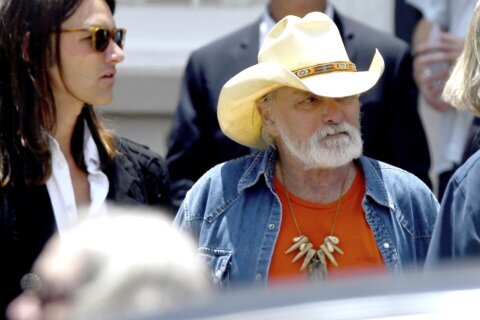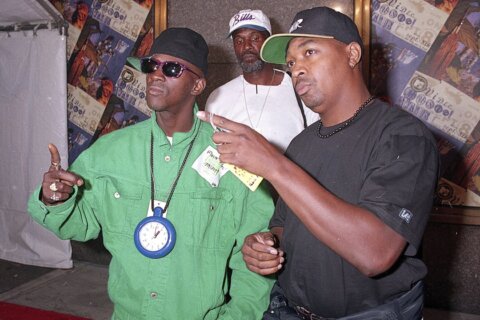WASHINGTON — Between the death of Debbie Reynolds and Golden Globe comparisons to “La La Land,” you’ve heard a lot lately about a 1952 classic.
This Sunday, MGM’s iconic musical “Singin’ in the Rain” returns to multiplexes in select locations to mark the film’s 65th anniversary in a partnership between Fathom Events and Turner Classic Movies.
If you somehow miss Sunday’s screening, have no fear. There will be an encore presentation on Wednesday, Jan. 18. Both screenings will feature commentary by TCM host Ben Mankiewicz.
Directed by Stanley Donen and Gene Kelly and written by Betty Comden and Adolph Green, the plot follows Don Lockwood (Kelly), who rises with vaudeville pal Cosmo Brown (Donald O’Connor) to become a silent movie star in 1927 Hollywood. After “The Jazz Singer” forces the industry into talking pictures, Lockwoord recruits singer Kathy Selden (Debbie Reynolds) to dub over the shrill voice of Lina Lamont (Jean Hagen).
Voted the Greatest Musical of All Time by the American Film Institute, it’s hard in hindsight to believe that “Singin’ in the Rain” somehow didn’t win the Golden Globe for Best Comedy/Musical in 1952. That award went to Walter Lang’s “With a Song in My Heart,” though the Globes did at least award O’Connor with Best Actor en route to two Oscar noms for Jean Hagen and Lennie Hayton’s score.
The snub may have been because Kelly had just won Best Picture the year before with “An American in Paris” (1951). Or, it may have been because the songs by Arthur Freed (lyrics) and Nacio Herb Brown (music) had appeared in prior MGM films: “The Hollywood Revue of 1929” (1929), “Lord Byron of Broadway” (1930), “Going Hollywood” (1933), “Stage Mother” (1933), “Sadie McKee” (1934), “Broadway Melody of 1936” (1935), “San Francisco” (1936) and “Babes in Arms” (1939).
Either way, the covers for “Singin’ in the Rain” have become the undisputed, definitive versions. The songbook features a number of classic numbers, including the backflips and pratfalls of “Make ‘Em Laugh,” the earworm chirps of “All I Do Is Dream of You,” the studio lot romance of “You Were Meant for Me,” the puddle splashes of the title number, the optimistic tapdancing of “Good Mornin’,” the 17-minute dream sequence of “Broadway Melody Ballet” and the love ballad “You Are My Lucky Star.”
Individually, these numbers will make you laugh, cry and swoon. Together, they form the pinnacle of producer Arthur Freed’s Technicolor musical streak at MGM, including “Meet Me in St. Louis” (1944), “The Harvey Girls” (1946), “Easter Parade” (1948), “On the Town” (1949), “Show Boat” (1951), “An American in Paris” (1951), “The Band Wagon” (1953), “Brigadoon” (1954) and “Gigi” (1958).
But the reason “Singin’ in the Rain” rises to the level of masterpiece isn’t just the song-and-dance delight from start to finish. In between these showstopping numbers, there’s a truly sparkling script that was recently voted the No. 65 Greatest Screenplay of All Time by the Writers Guild of America.
The script provides a masterful commentary on the transition from silents to talkies. Suddenly, actors have to speak into directional microphones and worry about proper pronunciation (“round tones”), while directors have to come up with innovative ways of blocking the scenes. One such scene is particularly hilarious, as Lockwood and Lamont’s director repeatedly yells, “Quiet please! Roll ’em!”
The whole thing recalls the lament of “Sunset Blvd.” villain Norma Desmond: “Back then we didn’t need to talk. We had faces.” It was a real problem that ended the careers of Buster Keaton, Mary Pickford and Douglas Fairbanks, articulated by Lina’s struggle with the line: “I caaaaan’t stand ’em!”
Still, beyond the iconic songs and the script’s social commentary, the real treat is watching these three performers go to work. Kelly is arguably the finest tapdancing machine we’ve ever seen on film, while O’Connor catapults with hilarious acrobatics and bends his shape-shifting face. Somehow, the adorable Reynolds, just 19 at the time, not only keeps up, but dazzles with her own fancy footwork.
Standing on top of a couch to the point that it tilts, she then collapses onto its upside-down cushions with laughter. That’s exactly how we feel watching “Singin’ in the Rain.” Reynolds, who died at age 84 on Dec. 28, 2016, will live on forever through this, the greatest film that she, or the genre, ever made.
This weekend’s “Singin’ in the Rain” event kicks off TCM’s series of monthly screenings:
- Jan. 15–18: “Singin’ in the Rain” (1952)
- Feb. 12–15: “An Affair to Remember” (1957)
- March 5–8: “All About Eve” (1950)
- April 2–5: “North By Northwest” (1959)
- April 23–26: “The Graduate” (1967)
- May 21–24: “Smokey and the Bandit” (1971)
- June 4–7: “The Godfather” (1972)
- June 11–14: “Some Like It Hot” (1959)
- July 30–Aug. 2: “Fast Times at Ridgemont High” (1982)
- Aug. 13–16: “Bonnie and Clyde” (1967)
- Sept. 17–20: “E.T. The Extra Terrestrial” (1982)
- Oct. 15–18: “The Princess Bride” (1987)
- Nov. 12–15: “Casablanca” (1942)
- Dec. 10–13: “Guess Who’s Coming to Dinner” (1967)
Click here for more info on the return of “Singin’ in the Rain” and here for more on the monthly screenings.








